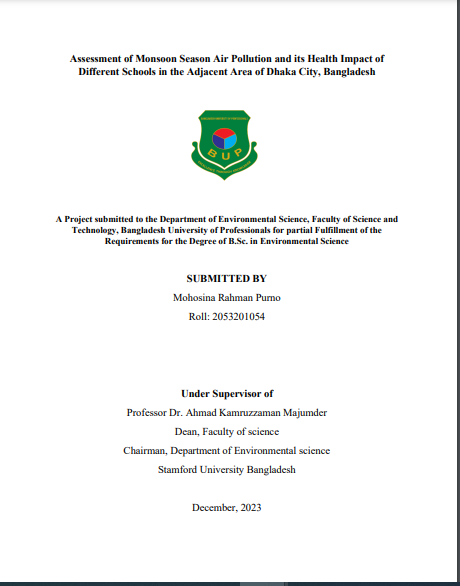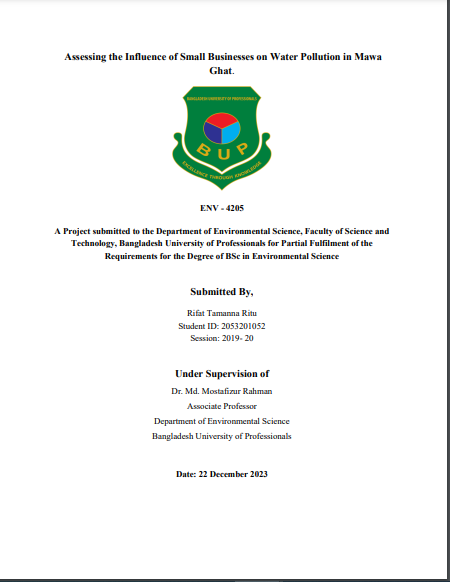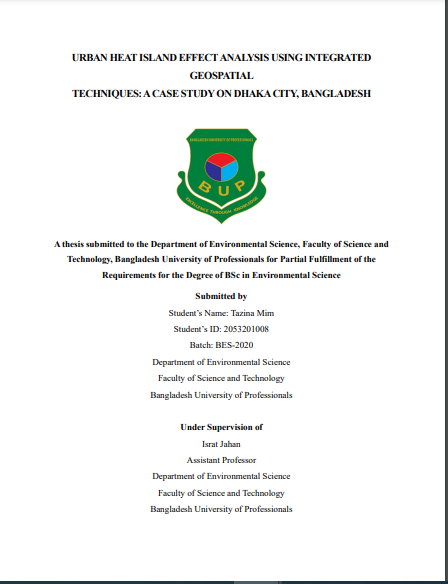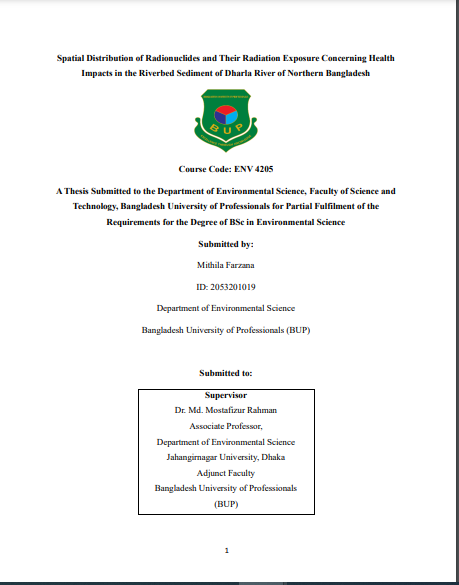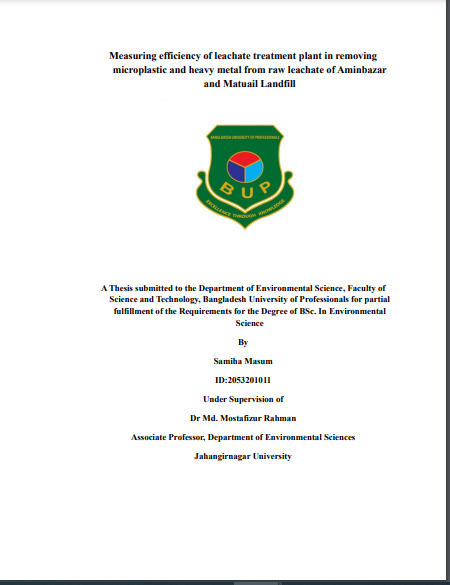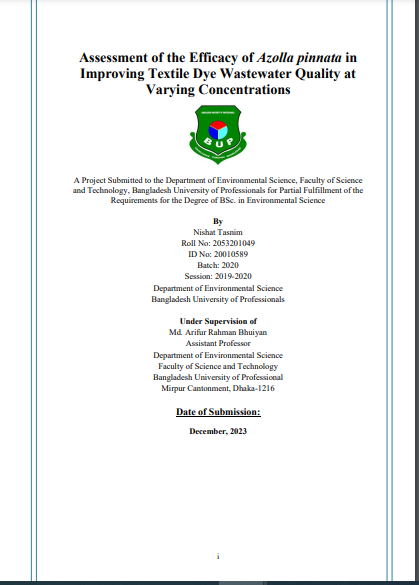
Executive Summary :
Azolla pinnata`s Role in Enhancing Textile Dye Wastewater Quality. In particular, the discharged water which consists of active ingredients such as dyes and coloration for the finishing of different fibers is more detrimental to human health as well as aquatic biodiversity. In the past few decades, large-scale wastewater discharge from the textile industries into the water bodies have been a major threat to society and environment of Bangladesh.
This study was conducted to investigate the efficacy of Azolla pinnata in improving the water quality of various concentration of textile dye wastewater. Some physicochemical parameters such as Temperature, TSS, TDS, DO, pH, EC, Turbidity, Salinity, Chemical Oxygen Demand (COD), Biological Oxygen Demand (BOD5) of the textile dye wastewater were observed before and after incorporation of Azolla pinnata without pH adjustment.
| Report Title : | Azolla pinnata`s Role in Enhancing Textile Dye Wastewater Quality. |
| University Name : | Bangladesh University of Professionals |
| Submitted To : | Md. Arifur Rahman Bhuiyan |
| Submitted By : | Nishat Tasnim |
| Total Page : | 77 |
Background of the Study
In the fiscal year 2021-2025, Bangladesh exported garments worth US $42.613 billion, making it the second-largest apparel exporter in the world (Government of the People’s Republic of Bangladesh, 2023). More than 84% of export revenue is generated from textiles and items that involve textiles. The textile industry contributes about 13% of the GDP.
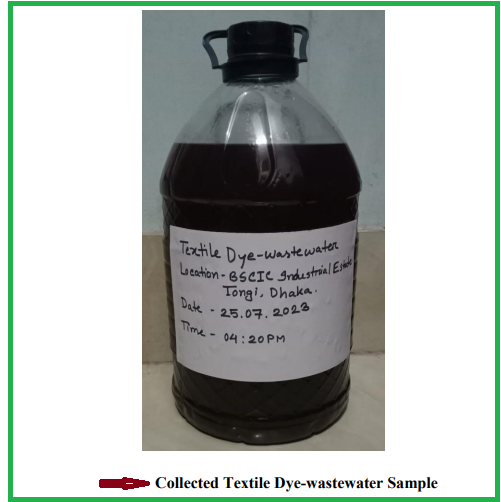
Approximately 4.5 million people are employed by these industries, 60% of them are women. The textile sector is well-known for its numerous beneficial contributions to the economy, but it is also well-known for its significant environmental and social challenges in terms of long-term sustainability. Despite significant economic contributions, Bangladesh textile industries cause a range of environmental problems; mostly it pollutes the water resources.
Problem Statement
At present textile is the largest and fastest growing sector in Bangladesh. Again these industries consume a large amount of water and commonly use active ingredients such as dyes and coloration for the finishing of different fibers. These active ingredients enhance the Chemical Oxygen Demand (COD), Biological Oxygen Demand (BOD) and Total Organic Compounds (TOC) of water and show toxic effects toward the environment as well as human body.
The discharge of untreated or not properly treated textile wastewater into water bodies can lead to severe environmental and health degradation. Various physical, chemical and biological methods such as adsorption, photolysis, chemical precipitation, chemical oxidation and reduction, electrochemical precipitation have been employed for the removal of pollutants from wastewater.
However, these technologies are usually not much effective in all pollutant removal, or are expensive and less adaptable to wide range of dye containing wastewaters
Research Question
- Can the quality of textile dye wastewater be enhanced by treating with Azolla pinnata?
- In which concentration of textile dye wastewater, Azolla pinnata works most efficiently to enhance the water quality?
Research Objectives
- To determine the efficacy of Azolla pinnata in enhancing the water quality of collected textile dye wastewater.
- To determine the concentration in which Azolla pinnata performs most efficiently to treat the textile dye wastewater.
Outline of the Report
The next chapters are organized as follows:
- Literature Review Chapter: Literature Review Under this chapter the local and international articles which are related to the thesis topic are reviewed and summarized and the research gaps are mentioned.
- Conceptual Framework Chapter: Conceptual framework under this section the abstract representation of the research study was delineated which is connected with the research study goal that directs the collection and analysis of data. Methodology Under this section the detail information about samples and data collection as well as the methodology of experiment and data analysis is described.
- Results & Discussion Chapter: 7 Results and Discussions Under this chapter the results obtained from the experimental work and data analysis are interpreted and discussed elaborately.
- Conclusion Chapter: Conclusion Under this chapter some conclusions are given.
- References & Appendix: All supportive document, tables, figures are listed here.
Conclusion
Now-a-days, Aquatic Macrophyte based Systems (AMS) are a significant modern technique for treating wastewater and eliminating adverse substances. The cultures of Azolla pinnata in the wastewater that contains dye elements in it, effectively eliminated Temperature, pH, BOD, COD, EC, TSS, TDS, Turbidity, Salinity and Absorbance in comparison to the control treatment and standards for industrial waste prescribed by DoE. Furthermore, the treatments increased the dissolved oxygen (DO) level in the wastewater.
However, among the three textile dye wastewater containing treatments, the T1 (30%) have shown the most efficient results in improving all the mentioned water quality parameters. This study suggests that Azolla pinnata can be a promising agent for the treatment of textile dye wastewater; which will ultimately benefit the surface water system.
